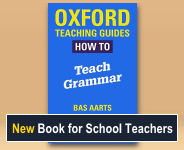Topic: Information structuring
This topic looks at how we can present the same information in different ways, by using different word orders and grammatical patterns. For instance, instead of I can understand that bit, we might change the order and say That bit I can understand to give a different emphasis. Learning about these different patterns helps in understanding the choices made by writers and speakers, and in varying the patterns used in our own writing for effect.
Englicious contains many resources for English language in schools, but the vast majority of them require you to register and log in first. For more information, see What is Englicious?

